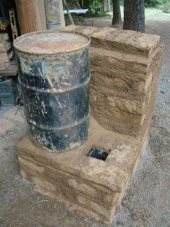


Willie Smits: Village Based Permaculture Approaches in Indonesia (video)
will be released to subscribers in:
soon!












God of procrastination https://www.youtube.com/watch?v=q1EoT9sedqY













God of procrastination https://www.youtube.com/watch?v=q1EoT9sedqY












I think you could reduce the footprint slightly running the stovepipe straight up through the top of the domes.
www.dragonheaters.com
http://blog.dragonheaters.com/





Cindy Mathieu wrote:
I think you could reduce the footprint slightly running the stovepipe straight up through the top of the domes.
If he did this, it would no longer be a bell. It would just be a funny looking flue system. The idea behind taking the exhaust from the bottom of each bell is that the coolest exhaust moves to the next bell and the warmest gases stay until they cool off by heating the inside of the dome.
I just wrote a post on the three issues which frequently confuse on another thread, Rocket Mass Heaters vs. Scandinavian / Slavic Masonry Heaters. Particularly, it would be useful if the combustion system is distinguished from what happens to the exhaust after it is created.
Tom's idea of a mold is interesting. What material would you use for the casting?
God of procrastination https://www.youtube.com/watch?v=q1EoT9sedqY














God of procrastination https://www.youtube.com/watch?v=q1EoT9sedqY









God of procrastination https://www.youtube.com/watch?v=q1EoT9sedqY




Tom Strode wrote:Wow, that open a whole new door. Do you have more pictures or a diagram to what's happening inside of that?

regards, Peter





















God of procrastination https://www.youtube.com/watch?v=q1EoT9sedqY


































 and all of it over head ! good luck, for the crafts ! Big AL
and all of it over head ! good luck, for the crafts ! Big ALSuccess has a Thousand Fathers , Failure is an Orphan
LOOK AT THE " SIMILAR THREADS " BELOW !





|
I want my playground back. Here, I'll give you this tiny ad for it:
Learn Permaculture through a little hard work
https://wheaton-labs.com/bootcamp
|









